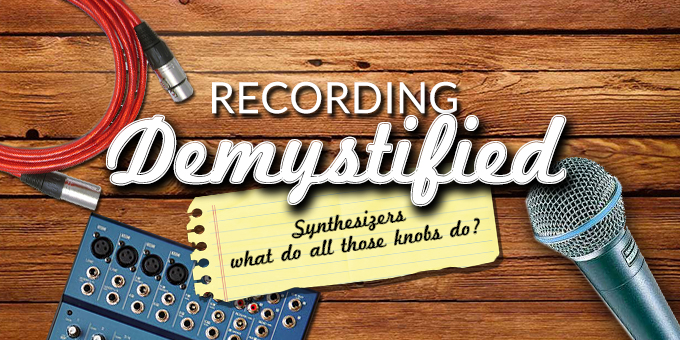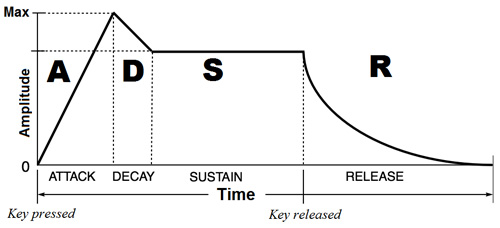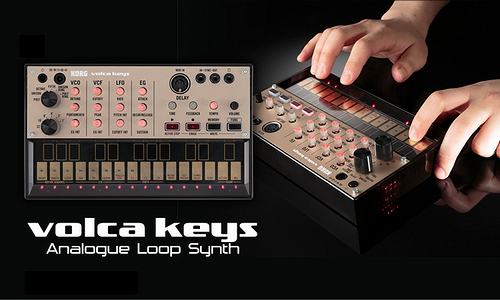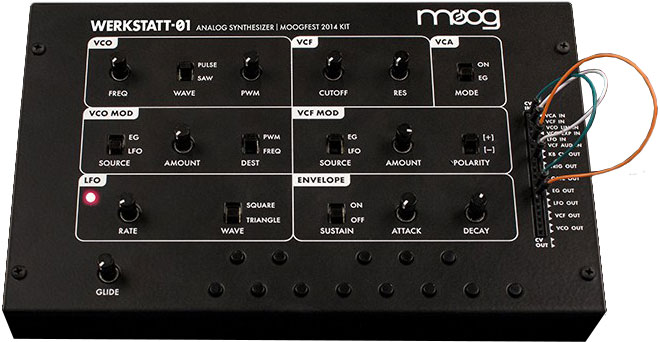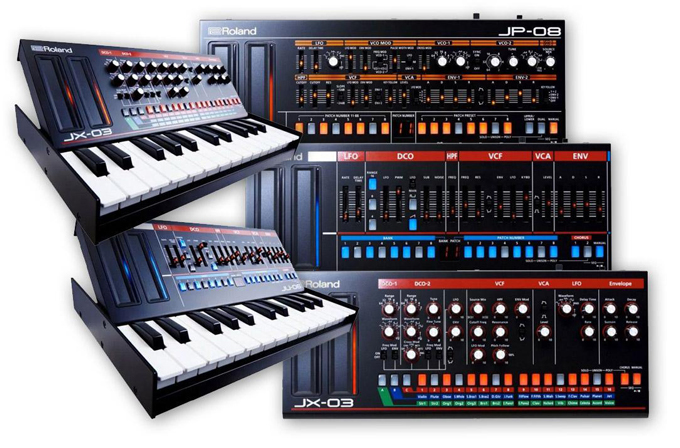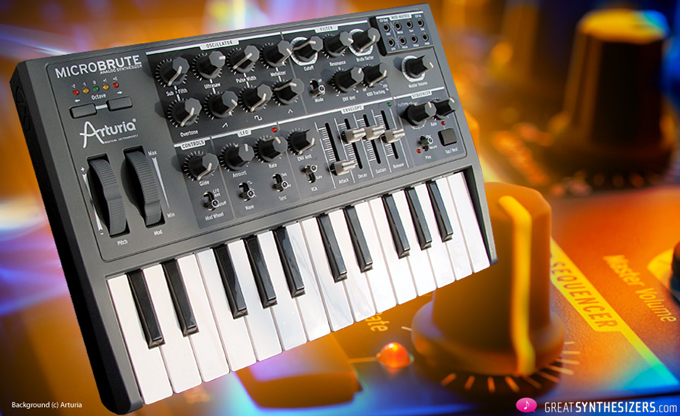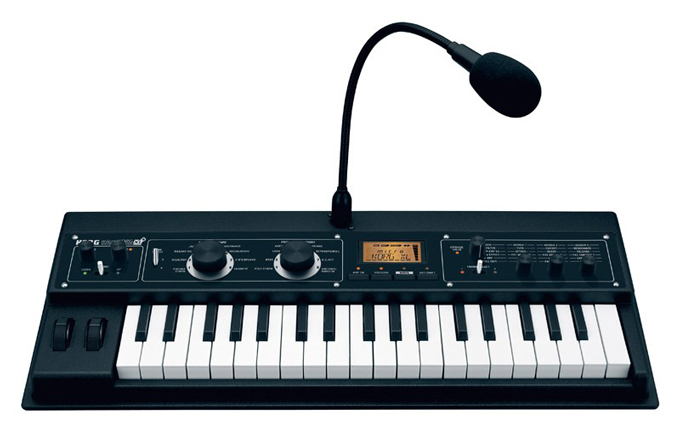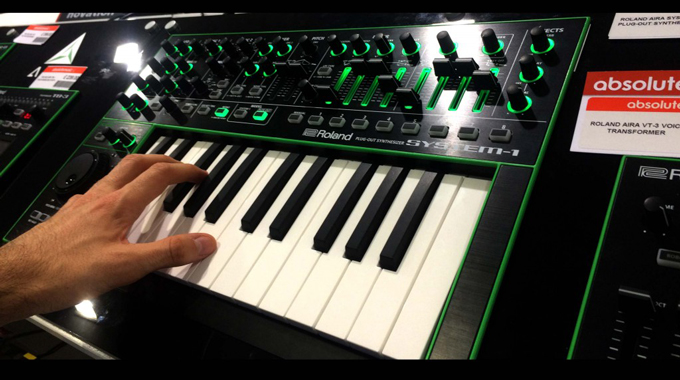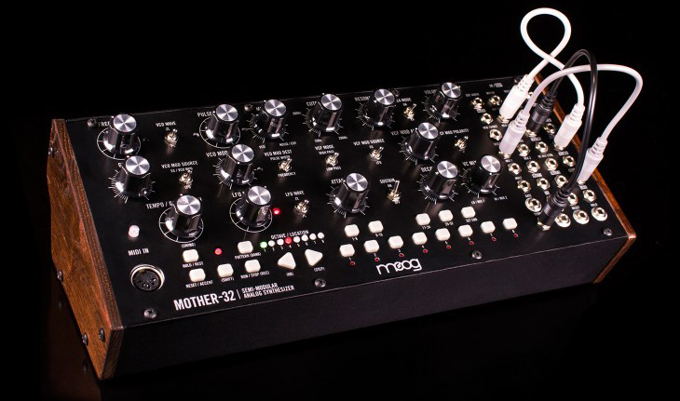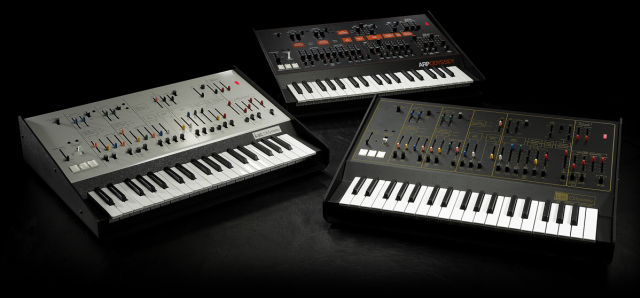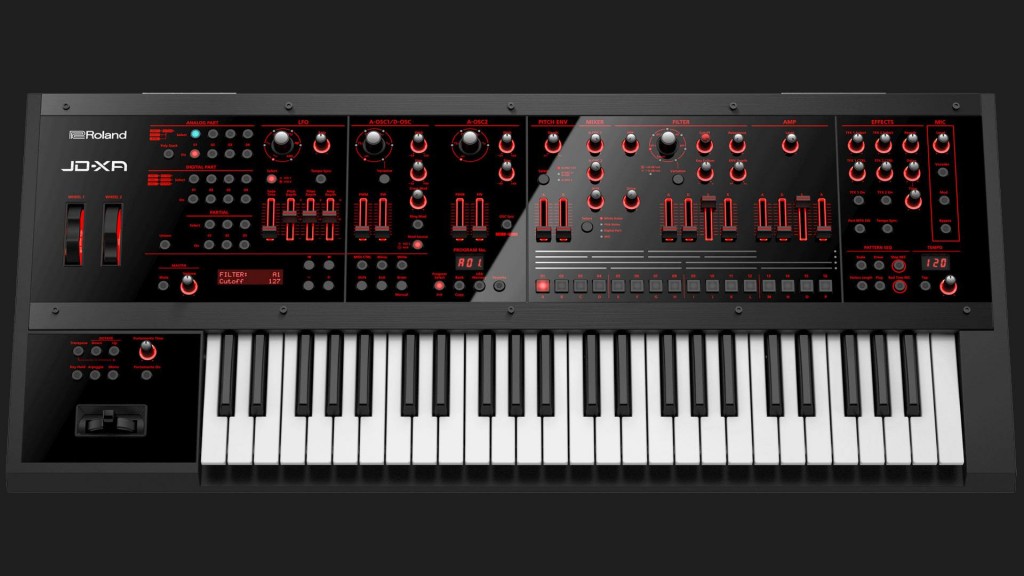Recording Demystified: Synthesizers – what do all those knobs do?
Posted on Tue 20 October 2015 in entries
The synthesizer has been forging new sounds, enabling ground-breaking music, and even creating entire genres since the 1960s and 70s when Bob Moog first brought the compact synthesizer to the masses and inspired musicians to experiment with new electronic sounds. Since then, instrument pioneers and advances in technology have brought us a whole host of weird and wonderful instruments, but during that time the fundamentals of synthesis have not really changed, and despite the many advances in digital technology things have gone full circle and the basic synthesizer is making a resurgence.
This article takes a look at the fundamentals of synthesis, and aims to point the reader in the right direction when it comes to choosing your first synth.
Read on to find out more…
A bit of synth history
In the early days of the BBC radiophonic workshop creating electronic sounds required a white lab coat, a considerable amount of electronics knowledge, and a lot of experimentation. Bits of equipment were cobbled together, hacked about and repurposed to create devices that could create or alter synthesised sound.
This way of creating musical tones was soon taken up by a handful of engineers, and synthesiser systems were built up by adding more units or ‘modules’ that each had a specific function – eg. waveform generation, envelope shaping or filtering. After a while, the more useful combinations of modules became apparent, and in 1970 Bob Moog changed the direction of synthesis by combining these modules into a much more compact and affordable single instrument - the MiniMoog.
These early electronic instruments were all analogue, relying on fairly basic components to create varying voltages that could be amplified and heard as sound. As the decade progressed, more manufacturers started making synths in the same way, and by the early 80s iconic instruments like Sequential Circuits Prophet 5, and Roland’s TB-303 and Jupiter 8 were available.
The 1980s then saw a shift towards digital technology, and another breed of synthesizers emerged that made use of this new technology. Previously, only basic waveforms could be generated, but now recorded sounds could be stored as samples, and other new synthesis techniques could be explored. Yamaha’s DX7 was a good example of an alternative method – it used ‘FM synthesis’ that relied on real time calculations of complex mathematical equations to create sound. Another popular synthesizer was the Korg M1 that used samples instead of basic waveforms, alllowing much more authentic emulations of ‘real’ instruments, as well as other previously unobtainable sounds.
Digital technology continued to push the boundaries of sound generation, and synths got more and more complicated through the 90s and into the millennium. Ultra-realistic ‘real world’ sounds, highly complex multi-layered sounds, comprehensive multi-track sequencing and song writing tools, and complete effects and mixing capabilities all became possible with more and more powerful digital signal processing (DSP).
In the last few years, despite the advances in DSP and computer technology that have paved the way for even more powerful synthesizers, more musicians are looking back to the early days of synthesizers, and not only the basic compact synthesizers are making a comeback, but modular synthesis systems are regaining popularity too. This resurgence of ‘old school’ technology is lighting a fire under a new generation of musicians who are finding that, when it comes to synthesis at least, some things just work, and all the technology in the world won’t necessarily make tried and tested synthesizer techniques better.
The rest of this article aims to guide the reader through the basics of synthesis so that when it comes to choosing a synth, you should have a better idea of what’s what, and be able to make a more informed decision about what to look out for.
Basics of synthesis
To understand what a synth is capable of you need to know about the fundamental building blocks that make a synthesiser work. These ‘blocks’ are combined to manipulate the sound, and the interaction between them can get quite complex, especially in modular systems. However, the basics are just that – they are fundamental, and apply to all ‘subtractive’ synthesisers (as opposed to additive or complex synthesis techniques that are beyond the scope of this article).
Oscillators
It all starts with an oscillator. An oscillator is the block that actually generates a waveform at a specific pitch. That waveform is usually restricted to a sine wave, triangle wave, sawtooth wave, square wave or noise. Often, two or more oscillators are combined to create more complex waveforms, and the interaction between them can produce a wide variety of tones. When two oscillators are used together, they can be completely independent or can be made to lock together – this is known as ‘oscillator synchronisation’ or ‘sync’.
Some synths also have a way of altering the waveform further using ‘waveshaping’. This is a feature that essentially distorts the waveform, creating more harmonics and altering the raw oscillator sound.
One further type of oscillator is a ‘sub oscillator’. This is another oscillator that is often an octave below one of the standard oscillators to add more depth to a sound, but often has less control over the waveform.
Envelopes
Envelopes are changes over time that are triggered by playing a note. The way an envelope changes over time can be controlled, and what the envelope actually changes can vary. A standard envelope is known as an ‘ADSR’ - this describes the four parts of the envelope: Attack, Decay, Sustain, Release. The best way to understand this is to visualise it on a graph:
By changing the time taken for each part of the envelope, different sounds can be created. For instance, if the envelope is controlling the amplitude (or volume), then this could be changed to produce short, percussive notes:
As you can see from the video above, envelopes make changes over time, and depending on the specific synth there may be a number of independent envelopes that can be used to control amplitude (volume), oscillator pitch, or filter frequency. So envelopes ‘shape’ the sound, and despite being a fairly simple concept, they provide a huge variation of sonic possibilities.
LFOs
An LFO (or ‘Low Frequency Oscillator’) is another way of creating a change over time, but an LFO (as the name suggests) creates changes regularly over time, oscillating back and forth. The waveform of the LFO could be any simple waveform, much like oscillator waveforms, the main difference being that the speed of the oscillation is much lower. Like envelopes, LFOs can be made to vary a number of things including amplitude, pitch, filter etc. and the number of LFOs on a particular synth will have a bearing on the complexity of the sound you can produce.
Filters
Filters are used to change the harmonic content (or ‘tone’) of a signal, and the characteristics of the filter can have a big effect on the overall sound of the synthesizer. Filters can be of a few types: high pass, low pass, and band pass, and these describe what frequencies are let through. A low pass filter, for example, allows low frequencies through, and makes higher frequencies quieter. As the ‘frequency’ of this low pass filter (LPF) is swept from low to high with the turn of a knob, the changing frequency content sounds really interesting, and of course you can also usually assign envelopes and LFOs to the filter frequency to make these filter changes over time.
Another aspect to filters is ‘resonance’. This is an adjustable boost at the cut-off frequency (the point at which the filter changes from passing the signal to not passing it), and adding resonance can have a dramatic effect on the sound.
Modulation
The way that one block/module can change another block/module is the basis of subtractive synthesis. This control over one parameter from another is known as ‘modulation’ – you are modulating (changing) a ‘destination’ parameter with a ‘source’ control. Some synths allow you to define lots of modulation assignments simultaneously, while others may not have flexible modulation, so this is an important aspect of any synthesizer, and really is where the power of a complex synth can make a big difference.
Examples of modulation sources/destinations include:
- LFO >> pitch - can produce a vibrato effect
- Envelope >> filter - a long attack could make the sound swell as it opens the filter
- Envelope >> pitch - could be used for a descending bass drop
- LFO >> volume - would produce a tremolo effect
- Velocity >> resonance - the harder you hit the key, the more ‘bitey’ the sound would get
Pulse Width Modulation
A special kind of modulation is Pulse Width Modulation (PWM). This is something not available on every synth, and has a unique sound. Fundamentally what it is, is a square wave where the waveform can be altered (modulated) over time, either manually, or by assigning a source (LFO or envelope) to the ‘width’ of part of the square wave.
This is easiest to visualise by looking at a square wave:
 As the width of the square pulse is changed, the harmonic content of the sound changes, so when the pulse width is varied over time, the sound becomes really interesting as the frequency content changes.
As the width of the square pulse is changed, the harmonic content of the sound changes, so when the pulse width is varied over time, the sound becomes really interesting as the frequency content changes.
Polyphonic, Monophonic and note triggering
So, we have our oscillator (or two) playing a note triggered by a press on a keyboard. What happens when we don’t let go of that note and play another one above or below it?
Well, that depends on the synthesizer’s ‘polyphony’, and what ‘note triggering mode’ the synth may be set to.
To play chords a synth needs to be ‘polyphonic’, ie. for each note of the chord that is played, the synth needs to have at least one independent oscillator to play each note. In the early days, synths were monophonic, and could only play one note at a time. As musicians started using synthesizers they soon wanted to play more than just melodies, so some synths were designed to play multiple notes by having a number of oscillators (plus additional envelopes and filters). This increased the cost dramatically, but was a breakthrough in electronic instrument design. The number of notes that can be played simultaneously is known as ‘polyphony’. So an 8-note polyphonic synth can play back 8 notes at once, and a 4-note polyphonic instrument can play 4 notes etc.
Related to this is how a synth might respond to new key presses. A monophonic synth can usually be set to jump to the next note played immediately, or if the synth has ‘portamento’ can glide from the old note to the new note, the speed of this glide can be set, and this is known as ‘portamento time’ or ‘glide time’. This cool feature has been used since early synthesizers, and can be heard on many recordings.
Another note triggering option is what happens when you let go of one note while holding down another. This can be a number of types: not do anything, play the held note if it is lower than the released note (‘lower note priority’), or play the held note if it is higher than the released note (‘higher note priority’). These note triggering modes can be used to allow fast legato-style playing where each note runs into the next, and is similar to a guitarist ‘hammering on’ or ‘pulling off’ notes by just moving the fingers of the left hand without repacking the note with the right hand).
Effects
Effects like reverb, delay, chorus and distortion can really make a synth sound come to life. However, a lot of synths (both old and new) may not have effects built in, and any effects would have to be added to the signal using another piece of equipment. When a synth does have effects, these can be programmed as part of the overall sound, and many good sounding presets on some synths may rely quite heavily on effects to produce the sound. Early synthesizers had very little in the way of effects, and quite a few of the modern synths available today also do not have many, or even any, effects on board. This may be an important factor when making a buying decision, so it’s always worth checking what effects are included.
Other things to look out for…
Physical layout
With so many controls, synths can look quite complicated. However, in many cases there is even more to a synth than meets the eye. Although some synths have just one knob per function, others have even more controls hidden away in menus. This has the advantage that there are more parameters to tweak, but the disadvantage that it is more complicated to use, and requires more time to learn the instrument as well as change the parameters you want to.
Technology
Synths can either be analogue, digital, or a hybrid using both technologies. True analogue synths tend to have a certain kind of sound, and are often more desirable but at the same time usually more expensive as they require more electronic components.
Digital synths usually use some kind of ‘modelling’ to emulate what analogue synthesizers do. The latest innovation, for example, is Roland’s ACB (Analog Circuit Behaviour) technology, where they have analysed and digitally emulated the electrical behaviour of all of the components in analogue synthesizers to reproduce the sound by recreating the circuit ‘virtually’ using DSP.
Control connections
Almost all synths can be controlled via MIDI, but some also use Control Voltages (CV) to allow control over parameters and to combine different synthesizers or modules to create bigger systems. Modular synths use CV control extensively, and is the way you have to connect a number of modules to create your sound. These connections are required for note/pitch control, and also to create all of the modulation assignments.
Patch memories
After spending ages fine-tuning your sound you may want to save it for use on another track, or to call up quickly in a live situation. ‘Patches’ are saved settings that bring back
Arpeggiators and sequencers
One feature found on a number of synths is an arpeggiator. This triggers a sequence of notes (or another varying control signal) just by playing a chord on a keyboard. This is a great way of injecting some life into a synth sound, and the tempo of the notes can be synchronised to your song by using MIDI clock, SYNC input, or CV pulse.
Sequencers, or ‘step sequencers’ are another way of adding life into a sound. A sequence of notes can usually be recorded, and then played back locked in time using MIDI or CV synchronisation.
Ring Modulation
Ring modulation or ‘ring mod’ is a feature that combines two oscillators. Instead of adding the signals together (mixing them), it multiples them. This creates additional notes that are related to the combination of the two oscillators, and can be used to create atonal and percussive sounds.
Vocoder
A vocoder (from ‘voice encoder’) is where an audio input (usually microphone) provides the frequency characteristic that is applied to a synth sound. The result is a very robotic sound, where the voice sounds like a synthesizer. Think Daft Punk!
So I know basically how synths work, where do I go now?
With the above knowledge about how subtractive synthesis works, you should be able to start understanding the differences between the capabilities of different synths. Below is a selection of currently available synthesizers with a brief description of what they offer. The terms used are explained above, so if you understand the descriptions then you know you are on the road to getting to grips with synthesis!
Sub-£400 synthesizers
Korg Volca Keys – a pocket sized, affordable, true analogue synth with very basic controls and no patch memories but a surprisingly big sound and an on-board sequencer. 3 note maximum polyphony, 3 oscillators, 1 filter (low pass), 1 LFO, and 1 envelope, battery operation, and a built-in speaker.
Korg Volca Bass – 3 analogue oscillators, 1 filter, 1 LFO and 1 envelope, built-in speaker, 16-step sequencer, portamento, sync and MIDI input. Great for 303-style patterns and bass lines.
Moog Werkstatt – a true analogue synth with one oscillator, patchable modulation assignments, and CV expansion option
Yamaha Reface CS – mini-key based on the Yamaha AN1X synth of the 90s, an analogue modelling synth with one-knob-per-function controls but no patch memories. 8 note polyphony, 5 oscillator types including ring mod, built-in speaker and battery power.
Yamaha Reface DX – a mini-key polyphonic synth emulating the classic DX7 synthesizer, with onboard effects, battery power and built-in speaker.
Roland Boutique – using ACB technology these synths faithfully emulate some classic Roland analogue synths: the JP-08 (Jupiter 8), the JX-03 (JX-3P), and the JU-06 (Juno 106). They are one-knob-per-function, and have patch memories. See the product pages for full descriptions.
Arturia Microbrute – a big sounding true analogue monophonic synth featuring mixable waveforms, sub oscillator, waveshaping, pulse width modulation, portamento, multimode filter (high, low and band pass), 1 envelope, 1 LFO, assignable modulation, step sequencer, CV control, and audio input to the filter.
Korg MicroKorg XL Plus – a mini-key analogue modelled polyphonic synth with additional sampled sounds, a vocoder with built-in microphone, powerful effects engine, battery power option, and sound editing software that updates the synth over USB.
Arturia Minibrute – big brother to the Microbrute, 100% analogue monophonic synth, mixable waveforms, sub oscillator, PWM, waveshaping, 2 LFOs, 2 envelopes, multimode filter, arpeggiator, audio input, MIDI, CV, and also serves as a USB MIDI controller.
Novation Mininova – a mini-key analogue modelling synth with 256 presets, and 128 user patch memories, 20 waveforms, 3 oscillators per voice, 14 filter types, 6 envelopes, 3LFOs, 20 modulation slots, up to 18 note polyphony, vocoder with onboard mic, comprehensive effects section, basic front panel controls, deeper editing via menus or using editing software, and ‘animate’ buttons for momentary sound variations.
Roland JD-Xi – an analogue/digital hybrid synth with separate analogue and digital synth engines, sequencer, vocoder with mic, drum patterns, up to 4 simultaneous effects, and USB for audio and MIDI connections.
Korg MS-20 Mini – a faithful analogue recreation of the classic MS20 from the late 70s, mini-key keyboard, 2 oscillators, 2 envelopes, 2 powerful filters, 1 LFO, flexible modulation patching, MIDI and USB.
Novation Bass Station II – a true analogue monophonic synth with 64 presets, and 64 user patch memories, 2 oscillators plus a sub oscillator, PWM, 2 envelopes, 2 LFOs, multimode filter, sequencer, arpeggiator, MIDI and USB.
Roland System-1 – a ground-breaking synth using ACB technology where the synth engine can be updated over USB to behave like different synths, many of which are emulations of classic Roland synthesizers. These installable engines (known as ‘plug-outs’) can also be used on a computer as a plug-in.
Synths over £400
Novation Ultranova – the big brother of the MiniNova with more hands-on control, analogue modelling, 3 oscillators per voice, 14 filter types, 6 envelopes, 3 LFOs, 20 modulation slots, up to 18 note polyphony, vocoder with onboard mic, and comprehensive effects section.
Moog mother-32 - a semi-modular synth with 1 dual output oscillator, PWM, classic Moog filter, 1 envelope, 1 LFO, sequencer, and CV patchbay for modulation assignments and connectivity with other modules.
Korg ARP ODYSSEY – another faithful recreation of a classic synth, true analogue, 2 oscillators with sync, 2 envelopes, portamento, and various filter types.
Moog Sub 37 – true analogue monophonic/paraphonic (2-note) synth with an option for independent voices, 2 oscillators plus sub oscillator and noise, classic Moog filter with audio input, 256 presets, arpeggiator/sequencer, extensive assignable modulation, and computer editor.
Roland JD-XA – a hybrid synth with independent 4-part analogue (2 oscillators), and 4-part digital (64 voice) synth engines, 4 envelopes and 2 LFOs per analogue voice, ring modulation, true analogue filters, 16 track pattern sequencer, comprehensive effects engine, and USB, MIDI and CV connections.
Sequential Circuits (Dave Smith) Prophet 6 – a true analogue powerhouse of a synth based on the original Prophet 5, with 6 note polyphony, 2 oscillators with sync plus a sub oscillator per voice, continuously variable waveshapes, PWM, 2 envelopes, 1 LFO, resonant low pass and high pass filters, polyphonic step sequencer, digital effects, one-knob-per-function layout, and extensive modulation assignments.
Modal Electronic 002 – analogue/digital hybrid synth, 12 note polyphony, 2 oscillators and 2 sub oscillators per voice, 1 LFO per voice, plus a global LFO, step sequencer/arpeggiator, and extensive modulation, plus ethernet port for updates and patch librarian.
Modal Electronic 008 – fully analogue 8 voice polyphonic synth, 2 oscillators + 2 sub oscillators, 2 LFOs per voice, PWM, and FM (frequency modulation), multi-mode filter, audio input, extensive modulation matrix, advanced sequencer/arpeggiator, and ethernet connectivity for cloud updates, storage and editing.
Modular synthesizers
In the last few years modular synths have been making a comeback. This comes full circle back to where it all started, with individual modules being connected together using CV signals with patch cables to create complex synth systems. Rather than talk about individual modules, here’s a few of the companies that make modular synths:
Shipped in from the US, Pittsburgh make a variety of modules that sound great, and also supply complete mini modular systems like the System 10.1 that includes specific modules.
A great modular company with ModStar modular and BoomStar semi-modular ranges, including the rather fat Sensei synthesizer that utilizes 12 ModStar modules.
The AIRA range includes a number of modules including the System1-M, Bitrazor (bit crusher), Scooper (scatter and looper), Torcido (overdrive/distortion), and Demora (delay).
A long standing synth company that is new to the world of modular. Their debut product, the NW1 Wavetable Module is a powerful oscillator with recordable waveforms.
